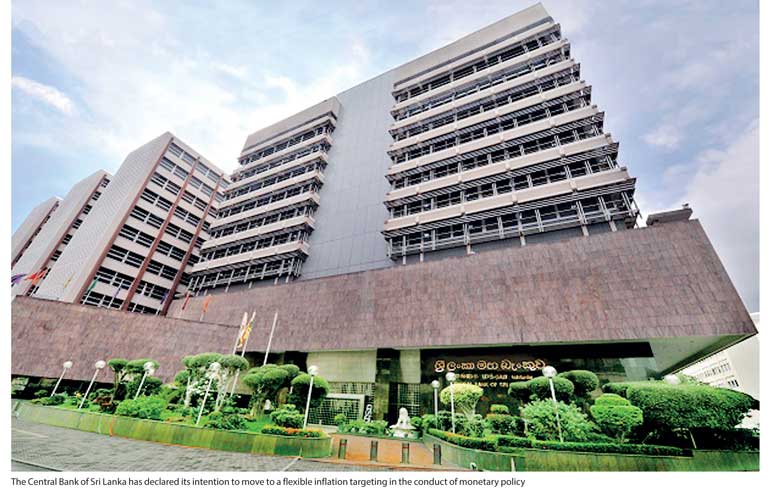Friday Nov 21, 2025
Friday Nov 21, 2025
Wednesday, 29 November 2017 00:00 - - {{hitsCtrl.values.hits}}
 While appreciating the Central Bank’s endeavour to shift to an inflation targeting or more precisely, to a flexible inflation targeting monetary policy framework, I would like to emphasise here that it is not an easy task to effectively implement such a policy strategy in a developing country like Sri Lanka, given the fiscal imbalances, debt burden and other macroeconomic constraints.
While appreciating the Central Bank’s endeavour to shift to an inflation targeting or more precisely, to a flexible inflation targeting monetary policy framework, I would like to emphasise here that it is not an easy task to effectively implement such a policy strategy in a developing country like Sri Lanka, given the fiscal imbalances, debt burden and other macroeconomic constraints.
These were already brought to light in my previous articles which appeared in the Daily FT (available at http://www.ft.lk/columns/The-political-economy-of-central-banking-in-Sri-Lanka/4-642422; and http://www.ft.lk/columns/Budget-2018-lacks-commitment-to-Central-Bank-s-inflation-targeting-crusade/4-643302).
An increasing number of advanced countries have switched to inflation-target based monetary policy frameworks in recent decades, following the success story of New Zealand which began inflation targeting in 1990. Inflation targeting has been increasingly adopted by the central banks in several developing countries as well. However, inflation targeting has not been without its critics, particularly in the context of developing countries.
The Central Bank of Sri Lanka has declared its intention to move to a flexible inflation targeting in the conduct of monetary policy.
Inflation targeting is a monetary policy framework under which a country’s central bank aims to keep a pre-announced inflation rate over a specific time frame. Transparency and accountability are two essential components of inflation targeting. Transparency implies that the central bank should convey the inflation target with justification through public announcements. Accountability means that the central bank should not miss the inflation target.
In practice, the Central Bank needs to give some weightage to economic stability as well, since strict inflation targeting might lead to economic fluctuations. Hence, flexible inflation targeting is considered more desirable to give leeway to the central bank to adopt discretionary monetary policy to mitigate such fluctuations as and when the need arises.
The central banks practicing inflation targeting use policy interest rates to influence the aggregate demand consisting of consumption, investment and foreign trade. The variations in aggregate demand affect inflation. Thus, inflation targeting focuses only on the demand side.
Obviously, there are many advantages of inflation targeting. It provides a nominal anchor for monetary policy and inflation expectations. There is clear evidence that inflation has come down in several countries after they adopted inflation targeting. Inflation targeting does not require a stable relationship between monetary aggregates and inflation as in the case of monetary targeting. All available information is used in formulating monetary policy under inflation targeting.
The greater emphasis given in inflation targeting to regular communication with the public has enabled the central banks in advanced countries not only to gain public confidence but also to get public support for price stability.
Shortcomings of inflation targeting in developing economies
The success of inflation targeting is bound to be limited in developing economies due to various structural constraints and the absence of prerequisites needed for such monetary policy shift. Central bank independence is crucial for using monetary policy instruments freely to maintain the announced inflation targets. When there is fiscal dominance compelling the central bank to print money to accommodate fiscal deficits, as in the case of Sri Lanka, the space available to the central bank to conduct monetary policy that targets low inflation is extremely limited.
Inflation targeting does not permit a central bank to use any other nominal anchor such as the exchange rate. But central banks in developing countries, in general, are promoted to keep the exchange rate within a pre-determined range to avoid volatility in cost of living and government’s debt service commitments.
Another shortcoming of inflation targeting is that it addresses only the demand side of the economy, as noted earlier. Developing countries, however, are highly susceptible to supply side shocks which generate what is called cost-push inflation. For instance, foods shortages caused by droughts and floods can lead to a steep increase in inflation. In order to identify the underlying inflation eliminating such temporary supply shocks, the Central Bank uses the measurement of core inflation. So, the influence of monetary policy is limited to core inflation, which is a part of headline inflation.
As envisaged in Vision 2025, the Government has initiated revenue-based fiscal consolidation to reduce the budget deficit and public debt in the medium-term. The Government expenditure will be rationalised by strengthening the Fiscal Responsibility Act with binding targets for fiscal deficit and public debt. The government also envisages to introduce liability management strategies to ease domestic and foreign debt burden while meeting its cash flow needs using an appropriate combination of debt instruments.
Although such initiatives are commendable, it is questionable how far those are going to be successful in the near future to facilitate the inflation targeting drive. The Central Bank seems to be overoptimistic with regard to the envisaged reduction of the fiscal deficit to 3.5 of GDP by 2020 so as to activate the inflation targeting process. It all depends on the Government’s commitment not only to revenue enhancement but also to expenditure cuts.
The fiscal deficit for 2018 is 4.8% of GDP, as announced in the Budget speech. It is doubtful whether the actual budget deficit could be retained within the announced target next year, given the frequent fiscal slippages in the  past and the possible spending spree amid the upcoming local government elections. The projected deficit for 2017 was 4.7% of GDP as per last year’s Budget speech, but the actual deficit has gone up to 5.2% of GDP.
past and the possible spending spree amid the upcoming local government elections. The projected deficit for 2017 was 4.7% of GDP as per last year’s Budget speech, but the actual deficit has gone up to 5.2% of GDP.
The limited fiscal consolidation achieved so far has been restricted to revenue enhancement mainly through increases in indirect tax mobilisation, adversely affecting the cost of living of masses. An improvement in income tax or direct tax mobilisation is expected with the implementation of the new Inland Revenue Act. Rationalisation of Government expenditure too is imperative for fiscal consolidation.
The Central Bank cannot have any target or nominal anchor other than inflation in a pure inflation targeting regime. By and large, this prevents the Central Bank interfering in the foreign exchange market to defend a pre-determined exchange rate, as practiced in the past. In other words, the exchange rate should be allowed to float in the market freely responding to demand and supply forces.
The impact of exchange rate changes on the real sector is substantial in Sri Lanka, given the significant import contents in the consumer basket and production structure. An exchange rate depreciation raises the general price level and in turn, cost of living. Similarly, exchange rate depreciation pushes up cost of production. The perfectly flexible exchange rate regime could, therefore, defeat the very purpose of inflation targeting.
In essence, prices should be deregulated fully for the successful operation of inflation targeting. In Sri Lanka, administered prices account for a substantial portion of the consumer price index, and therefore, the influence of monetary policy is confined to non-administered price items.
Exchange rate depreciation could also have significant effects on debt service burden where levels of foreign currency denominated debt is high, as presently experienced by Sri Lanka.
The external debt service payments, consisting of loan repayments and interest payments, are projected to rise from US dollars 2,132 million in 2017 to dollars 2,819 in 2018. Thereafter, there will be a bunching of debt service payments during 2019-2022 reaching a peak level of dollars 4,217 million in 2019.
Given these growing debt commitments, a marginal depreciation of the rupee will have a considerable impact on the budget. For instance, 1% depreciation of the rupee will increase the government’s external debt service payments roughly by a whopping Rs. 4.4 billion in 2018 and by Rs. 6.5 billion in 2019.
These additional expenditure outlays will obviously expand the fiscal deficit compelling the Government to increasingly rely on the Central Bank to borrow money by way of money printing or seigniorage. This counteracts inflation targeting which is designed on the grounds of fiscal consolidation
In such a situation, leaving the exchange rate to market forces, as required by inflation targeting, is likely to bring about heavy fiscal burden. Hence, one could argue that some foreign market intervention many not be inconsistent with inflation targeting in difficult times as long as the motives for such deviations are fully communicated and understood.
Inflation targeting is recognised worldwide as a desirable monetary policy framework to combat the evil of inflation. The success of such policy drive, however, depends on many factors particularly in emerging market economies like Sri Lanka, and therefore, we cannot expect miracles from a shift to inflation targeting.
Sri Lanka faces precarious problems as regards acute fiscal imbalances, accumulated debts and balance of payments deficits. These problems are unlikely to be resolved in the near future although both the Government and the Central Bank have announced a series of corrective measures encompassing fiscal consolidation and inflation targeting.
It is questionable whether Sri Lanka is ready to implement inflation targeting or the declared flexible inflation targeting framework. The fiscal deficit is likely to expand further in the absence of any visible expenditure rationalisation and the fragile revenue structure. The present Government’s continuous borrowings for infrastructure projects such as the Central Expressway and the proposed Light Rail system will further enhance the debt service burden aggravating the fiscal imbalance.
On the foreign exchange front, the trade deficit continues to widen in the background of sluggish export performance and rising imports. Worker remittances, which has been a main source of foreign exchange earnings, begin to slow down exerting considerable pressures on the balance of payments and the exchange rate. Meanwhile, foreign exchange flows have been further liberalised under the Foreign Exchange Act, No.12 of 2017. Given the market uncertainties, much improvement in foreign exchange inflows cannot be expected through the incentives given under this Act. If at all, there is a likelihood of capital outflows, though it is too early to predict the outcome of the exchange liberalisation under the Act.
The current macroeconomic setting seems to be detrimental to effective application of inflation targeting, though it is desirable from the viewpoint of macroeconomic stability.
(The writer is Emeritus Professor, Open University of Sri Lanka.)